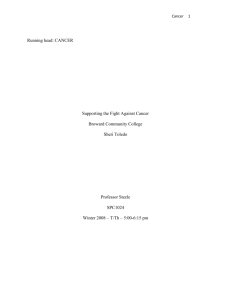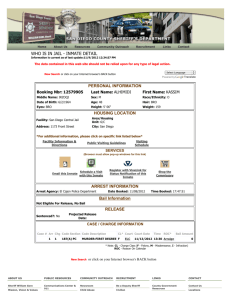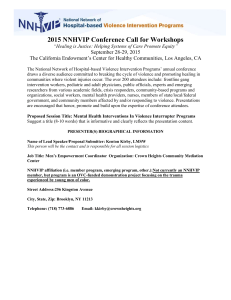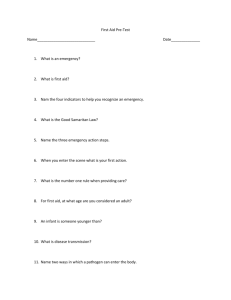category a – no apparent risk of further harm to victim and/or children
advertisement
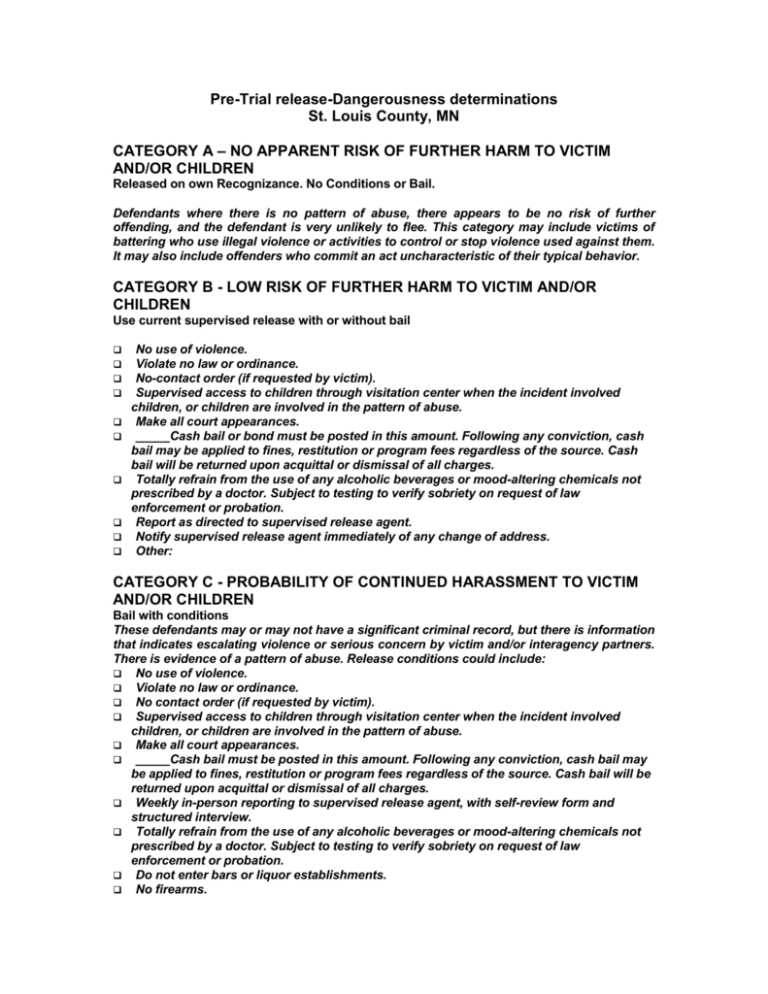
Pre-Trial release-Dangerousness determinations St. Louis County, MN CATEGORY A – NO APPARENT RISK OF FURTHER HARM TO VICTIM AND/OR CHILDREN Released on own Recognizance. No Conditions or Bail. Defendants where there is no pattern of abuse, there appears to be no risk of further offending, and the defendant is very unlikely to flee. This category may include victims of battering who use illegal violence or activities to control or stop violence used against them. It may also include offenders who commit an act uncharacteristic of their typical behavior. CATEGORY B - LOW RISK OF FURTHER HARM TO VICTIM AND/OR CHILDREN Use current supervised release with or without bail No use of violence. Violate no law or ordinance. No-contact order (if requested by victim). Supervised access to children through visitation center when the incident involved children, or children are involved in the pattern of abuse. Make all court appearances. _____Cash bail or bond must be posted in this amount. Following any conviction, cash bail may be applied to fines, restitution or program fees regardless of the source. Cash bail will be returned upon acquittal or dismissal of all charges. Totally refrain from the use of any alcoholic beverages or mood-altering chemicals not prescribed by a doctor. Subject to testing to verify sobriety on request of law enforcement or probation. Report as directed to supervised release agent. Notify supervised release agent immediately of any change of address. Other: CATEGORY C - PROBABILITY OF CONTINUED HARASSMENT TO VICTIM AND/OR CHILDREN Bail with conditions These defendants may or may not have a significant criminal record, but there is information that indicates escalating violence or serious concern by victim and/or interagency partners. There is evidence of a pattern of abuse. Release conditions could include: No use of violence. Violate no law or ordinance. No contact order (if requested by victim). Supervised access to children through visitation center when the incident involved children, or children are involved in the pattern of abuse. Make all court appearances. _____Cash bail must be posted in this amount. Following any conviction, cash bail may be applied to fines, restitution or program fees regardless of the source. Cash bail will be returned upon acquittal or dismissal of all charges. Weekly in-person reporting to supervised release agent, with self-review form and structured interview. Totally refrain from the use of any alcoholic beverages or mood-altering chemicals not prescribed by a doctor. Subject to testing to verify sobriety on request of law enforcement or probation. Do not enter bars or liquor establishments. No firearms. Notify supervised release agent immediately of any change of address. Other: CATEGORY D – HIGH PROBABILITY OF FURTHER HARM TO VICTIM AND/OR CHILDREN: Bail with conditions, including supervision by adult intensive supervision unit. These are defendants with a serious history of offending and/or used serious violence causing injuries that required hospitalization. Conditions of release could also include: No use of violence. Violate no law or ordinance. No-contact order (if requested by victim). Supervised access to children through visitation center when the incident involved children, or children are involved in the pattern of abuse. _____Cash bail must be posted in this amount. Cash bail will be forfeit upon violation of any of these conditions. Following any conviction, cash bail may be applied to fines, restitution or program fees regardless of the source. Cash bail will be returned upon acquittal or dismissal of all charges. Totally refrain from the use of any alcoholic beverages or mood-altering chemicals not prescribed by a doctor. Subject to testing to verify sobriety on request of law enforcement or probation. Do not enter bars or liquor establishments. Notify supervised release agent immediately of any change of address. No firearms. Other: CATEGORY E - HIGH PROBABILITY OF SERIOUS HARM TO VICTIM AND/OR CHILDREN: Jail These are defendants with a serious and lengthy history of violent offending, and/or the incident involved extreme violence, (e.g. murder,) where there release would be inimical to public safety or it is extremely unlikely they will reappear at court. These defendants will be held in jail without bail. Appendix E. Domestic Violence–Related Misdemeanor Sentencing Recommendation Matrix Category one Category two Category three Category four The offender commits an offense against the victim but there is no evidence to suggest the offender is battering the victim. The offender has no history of battering. The offender engages in battering behavior against the victim, but there is no indication that the battering is escalating in severity or frequency, or that this offender has battered another person. The offender has established a The offender’s PSI demonstrates clear pattern of battering with that the heightened, obsessive, this or past victims. The PSI and/or unrelenting nature of the indicates the battering will likely battering poses a high risk of continue and possibly escalate serious harm to this or other victim in severity and frequency. This category may include offenders who commit an act uncharacteristic of their typical behavior. It may also include victims of battering who use illegal violence or activities to control or stop violence used against them. This category may include batterers whose histories include using low levels of violence and activities which threaten or intimidate the victim. Considerations: If the offender in this case is experiencing ongoing battering by the person assaulted, the probation officer considers safety measures for both parties. Specialized programming is recommended, and the probation officer does not consider executed jail time unless the assault is severe. Considerations: Recommendations focus on victim safety and rehabilitation programming rather than sanctions. This category may include batterers whose histories include multiple domestic violence–related contacts with the police; demonstrated harassing behavior* toward the victim; violation of an OFP; or repeated threats or assaults against this or other victims. The victim may be in fear of serious bodily harm. This category includes offenders with histories similar to those of category 3 offenders but may also include stalking behavior,* threats to seriously harm or kill; use of weapons or threats to do so; and injuries that require medical attention. Considerations: Recommendatio Considerations: Victim safety include the strongest victim safety recommendations are combined measures possible, including work with more sanction-oriented with child protection on children’s s sentencing, such as the A substantial jail term and long-t maximum probationary period, probation may be combined with some executed jail time, and programming if offender is amena rehabilitation programming. *terminology on page five Incarceration or other correctional programming* 30 days stayed jail 60 days stayed jail 60 days stayed jail 10-30 days executed jail Gross misdemeanor incarceration or other correctional programming* 91-120 days stayed jail 91-120 days stayed jail 0-45 days executed jail 45-120 days executed jail Probation duration (Gross misdemeanor convictions routinely receive 2 years probation 1 year © Arrowhead Regional Corrections and Domestic Abuse Intervention Project, Duluth, MN 60-90days stayed jail 20-30 executed jail 120-180 days stayed jail 120-180 days executed jail 2 years




